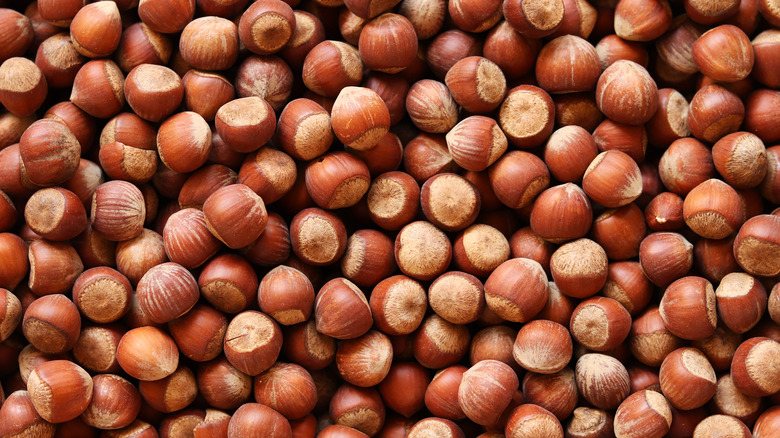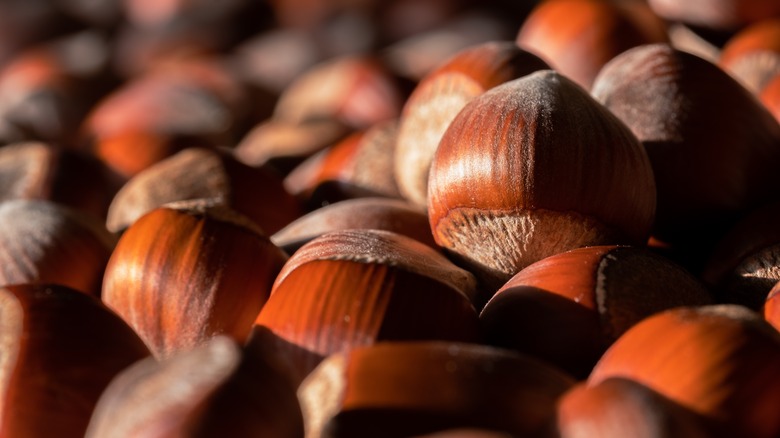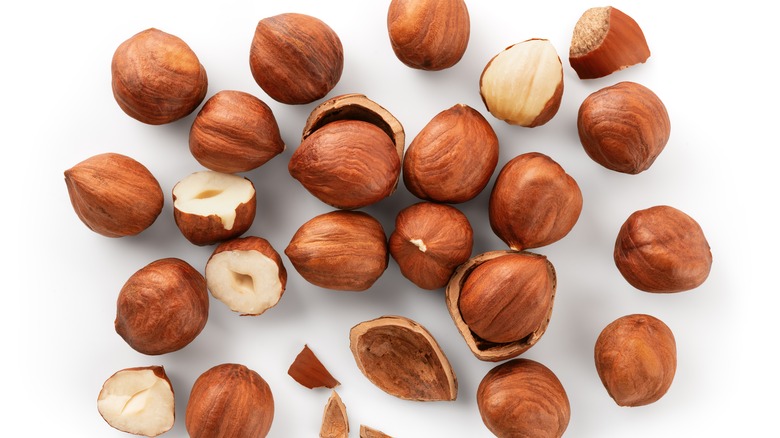This State Produces The Most Hazelnuts In The US
Hazelnuts are among the most popular, albeit expensive, nuts in the U.S. Used for the glorious chocolate-hazelnut spread known as Nutella as well as plenty of savory dishes, there is no shortage of things to make with hazelnuts.
According to Money Inc, hazelnuts were the tenth most expensive nut in 2019, with average prices ranging from 61 to 91 cents per pound. But the prices aren't enough to slow down consumers. In 2018, hazelnuts were the sixth most popular nut worldwide (via World Atlas) with no signs of slowing down. According to Report Linker, the hazelnut market could grow by nearly $2.5 billion between 2022 and 2026.
The demand for hazelnuts is high, and the market needs many suppliers to meet that demand. But who grows all of those hazelnuts? For the answer, we'll need to look to the northwest region of the U.S. for the single state that produces almost all of the country's hazelnuts.
It's nuts when you think about it
According to Oregon State University, as of 2017, 99% of the country's hazelnuts were grown in Oregon. OSU adds that the other 1% of domestically produced hazelnuts come from Washington, and the number of hazelnuts grown in the region makes up between 3% and 5% of the world's entire hazelnut production.
87,000 acres of Oregon farmland are now dedicated to hazelnut growth, according to Oregon Hazelnuts. And the major production translates to a significant payday. The organization adds that growers earned an impressive average of around $70 million over the last five years for the nutty crop.
While these numbers are noteworthy, they don't come close to the hazelnut production outside of the U.S. By a considerable margin, Turkey grows the most hazelnuts in the world. A whopping 82% of the world's hazelnuts come from Turkey, with Ferrero (the company that produces Nutella, Ferrero Rocher, and Kinder confections) being their top importer (via France24). According to NPR, Ferrero needs about a quarter of the entire world's hazelnut supply to keep churning out their sweets. The demand is so high that the company also buys hazelnuts from high-producing Oregon farmers (via OPB).
So what's next for hazelnuts in the U.S.? Scientists working on specially-bred hazelnuts believe the Midwest is poised for a surge in hazelnut growth (via Star Tribune). We may see some of the hazelnut production distributed across the country in the future, but for now, Oregon remains America's hazelnut king.
Where they come from and where they're going
Hazelnuts, also known as filberts, are the fruit of the hazel tree (via Britannica). The European hazelnut, also known as the common hazelnut, is the most popular variety for commercial production (per Rutgers). These nuts are native to Europe and western Asia, says the Arbor Day Foundation. According to JSTOR, the European hazel trees first took root in Ireland about 10,000 years ago. JSTOR adds that in addition to humans enjoying the nut, birds, wild boars, and other mammals would feast on hazelnuts in the Mesolithic era.
Today, there are many varieties of hazelnuts worldwide, including beaked hazelnuts and American hazelnuts, both native to North America (via JSTOR). However, despite there being hazelnuts native to the continent, according to Oregon State University, the European variety appears to be the most preferred, with 70,000 acres of Oregon crops devoted specifically to growing European hazelnut trees. Even though European hazelnut trees are more susceptible to lethal disease (per University of Wisconsin — Madison), their growth throughout the U.S. is likely because the European variety produces larger hazelnuts with a better flavor (via NDSU).
Scientists are working to pump up domestic hazelnut production by cross-breeding European hazelnuts with native varieties to create a commercial-quality variety that is resistant to disease and can thrive when planted in America (via Arbor Day Foundation).
Hazelnuts and health
The benefits of hazelnuts reach far beyond their delicious flavor. According to Healthline, incorporating hazelnuts into your diet may improve heart health, prevent oxidative stress, and reduce blood sugar levels. Raw hazelnuts are sold in skinless and skin-on varieties, but don't be afraid to grab the bag with the skins still on! Though the skin can taste bitter, according to Cooking Light, Healthline also says these edible, papery films contain most of the hazelnut's antioxidants.
Hazelnuts make for a tasty, low-carb snack that includes a healthy amount of fiber and unsaturated fats, aka the kind of fat that is good for you (via VeryWell Fit). Though hazelnut-based goodies like Nutella are fun to eat, Medical News Today recommends avoiding them when focusing on hazelnuts for health because of their high sugar content. Of course, too much added sugar is unhealthy for anyone's diet, but that doesn't mean you can't enjoy dishes like Nutella French toast in moderation. And when you do, remember that some of the hazelnuts in that delectable jar may have originated in Oregon, the largest hazelnut producer in the U.S.



